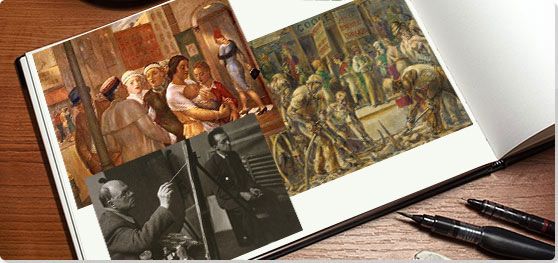Summary of Fourteenth Street School
Centered around the bustling Union Square in downtown New York, the artists of the Fourteenth Street School depicted an array of urban denizens before and during the Great Depression. Working in a realistic manner, artists such as Kenneth Hayes Miller, Raphael Soyer, Isabel Bishop, and Reginald Marsh, painted the working men and women, the middle-class shoppers, and the sidewalk hawkers with humanity and, at times, with a touch of cynicism. Disavowing modernist calls for art for art's sake, the Fourteenth Street School reveled in the messiness of ordinary life and used their painting to call attention to the lives of ordinary people.
Falling out of favor with the rise of Abstract Expressionism, the artists of the Fourteenth Street School persisted with figurative painting and were influential for younger artists, such as Fairfield Porter and Jane Freilicher, who pursued figurative painting after World War II. Subsequently their work has been reassessed and put into the context of larger, international trends of figurative paintings.
Key Ideas & Accomplishments
- Rather than depicting the idealized and romanticized rural subjects of contemporaneous American Regionalism, the Fourteenth Street School painters concentrated on urban scenes, embracing the grittiness and dynamism of the city. Their commitment to Social Realism shined a light on the working poor as well as a new, emerging middle class.
- Throughout the paintings of the Fourteenth Street School artists, one senses the tensions between traditional values, mass culture, and a burgeoning consumerism even in the midst of the Depression. From classical-looking middle class shoppers to the uglier sides of department store sells, the Fourteenth Street School depicted the complex, sometimes paradoxical, aspects of capitalist culture in the urban environment.
- Most of the artists in the Fourteenth Street School looked to the artists of the Renaissance and Baroque, particularly Michelangelo, Peter Paul Rubens, and Rembrandt, as models not only for their figural depictions but also for their spatial compositions and arrangements. This emulation of the Old Masters imbued their modern subjects with humanity and gravitas.
- Many of the artists depicted images of the New Woman in various guises. As women gained more social and financial independence, securing work outside of the home, new styles and attitudes developed, and the artists variously engaged these developments in their paintings.
Overview of Fourteenth Street School
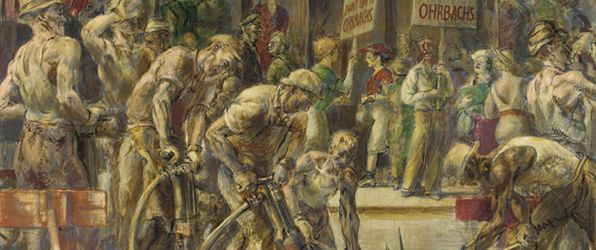
In 2018, a Guerrilla collective called The Illuminator made the buildings of Fourteenth Street in the East Village their canvas to protest the Supreme Court nomination of Brett Kavanaugh. But this was not the first time the area has proven an artistically rich locus. In the 1920s, this bustling thoroughfare was the birthplace of a school of art which gave new color to the Great Depression.
Artworks and Artists of Fourteenth Street School
Leaving the Bank
This painting depicts a fashionably dressed matron in three quarters pose as she leaves the bank, its marble columns framing her within a context of material prosperity and institutional power. As Ellen Wiley Todd wrote, "Miller orchestrated the picture...to make her an image of classical stability and repose. Placed close to the picture plane, she dominates the scene .. .Her columnar stance - arms held close to her rounded body - partakes of the architectonic qualities of the massive supports behind her." Miller's treatment was influenced by Rubens' and Renoir's images of women bathers, but rather than the vitality of the nude, he emphasizes a contemporary sense of material prosperity and feminine propriety. The woman's fashionable clothing, her cloche hat, fur-collared coat, and white leather gloves, are essential elements of the work; as Todd noted, "Miller transformed the shopper into a goddess of commerce." The controlled brushwork further contributes to a sense of polished perfection, while at the same time the architectural columns visually evoke "the pillars of society," and the woman's gaze, not meeting the viewer's, conveys a sense of urbanity and class disdain.
Miller's innovative images of matronly shoppers had a dominant influence upon Bishop, Marsh, Laning, and the Soyer brothers and became a defining characteristic of the movement. Largely forgotten at the time of his death in 1952, Miller's work was rediscovered in the 1970s and has been featured in several contemporary exhibitions.
Oil on canvas - Virginia Museum of Fine Arts, Richmond, Virginia
Breezy Day on the Avenue
This work depicts two well-dressed matrons, accompanied by a young boy and a small dog, huddled together facing into a strong wind, while a man, hanging on to his hat, passes by on the left and a woman passes on the right. Though the painting is only 8 ¾ x 6 ½ inches, the figures seem statuesque and monumental. The Rubenesque figures and strong arms and legs are depicted with a three dimensionality that is emphasized by the flat background and the repeating curves of their forms and clothing. The animated movement of the wind reveals and sculpts the group, pressing the women's dresses against them and unifying the group.
Raised in Illinois, Laning later moved to New York where he studied with Sloan, Marsh, and Miller. He originally rejected Miller's artistic approach as too conservative, but after delving into the works of Peter Paul Rubens on a 1929 European trip, he studied with the artist for several years upon his return. Laning wrote of his mentor, "He had a remarkable faculty for making art the thing one lived for .. My identification with him was almost complete for a time. I guess I turned him into my father." Here, in this depiction of two older middle-class women, dressed in the flapper style of the 1920s, as they are out shopping, Laning has adopted Miller's preferred subject but added his own contribution of dramatic narrative. Laning's emphasis on the unsettling moments of ordinary life was a unique contribution to the movement. In the 1930s, he created a number of notable murals for the WPA that have become his most famous works.
Oil on canvas, 8-3/4 x 6-1/2 inches - Collection of John P. Axelrod
The Fitting Room
This painting shows a women's fitting room, where a woman just right of center, her arms positioned in a classical pose, is trying on a gold dress as she is attended by an older salesclerk. To the right, three well-dressed women converse as they stand in a circle, the curving swirls of their clothing and limbs evoking Renaissance paintings of the three Graces, a configuration that Miller employed in other works as well. The woman in gold is both matronly and voluptuous, and viewers of the time would probably have recognized her pose as reminiscent of "the Jean Harlow publicity pose and its overt display of a potent and, as some contemporaries would have argued, liberated sexual self," as art historian Ellen Wiley Todd explained. The strong perspective of the gold and silver tiled floor, emphasized by the horizontal and vertical lines of the walls, evokes a classical setting thus underscoring the comparisons of the modern shoppers with ancient goddesses.
Oil and tempera on canvas, mounted on Masonite - Metropolitan Museum of Modern Art, New York
Dante and Virgil in Union Square
This work shows a crowd at Union Square, the equestrian statue of George Washington in the center framed by the Union Square Savings Bank and other buildings in the background. Yet what makes the painting startling is the inclusion of the 13th-century Italian poet Dante and the 1st-century BCE Roman poet Virgil in the foreground. Facing the crowd, the robed figures seem to be discussing the scene before them, and the two evoke Dante's poem the Inferno (1308-1320), an account of his journey through hell while guided by Virgil. Busy with their own affairs, a woman leading her child by the hand, pairs of women walking away from the crowd, and a number of working class men, portrayed in darker colors, facing into the Square seem completely unaware of the classical figures, who stand in the shadowed foreground of the sidewalk, as if embodying the evaluating gaze of another era.
The composition of the work, divided into three zones, both horizontally and vertically, creates a serene sense of order and reflects the influence of the Renaissance artist Pierro della Francesca. Bishop created this work for Miller's mural course, a class in which he emphasized Renaissance composition, while she also drew upon her own background. Her mother aspired to be a writer and translate Dante's Inferno. The painting's focus on women, lit up in sunlight and at the front of the crowd, emphasizes their rising ambitions and desires.
Bishop said of the work, "I don't consider Union Square the Inferno at all, but a place where one is confronted with a multitude of souls." While the neighborhood was diverse in ethnicity and class, as Todd noted, Bishop portrayed it "as a universalized community of urban dwellers...everyone has been 'Americanized.'" She also creates a sense of political and social order, as the work resembles a kind of secular triptych, the central panel dominated by the equestrian statue, where George Washington seems to direct the crowd with his outstretched arm, his figure and horse rendered in dark shadow and light, like a compelling symbol. Pairs of women in fashionable hats and clothing, symmetrically placed on both the left and the right, walk toward the viewer, whose attention is drawn to them by the verticals above them. As a result, the women themselves become a kind of implicit embodiment of another kind of social order, contrasting with the pair of classical men contemplating the scene. As art critic Jane Addams Allen wrote of Bishop, "She is brilliant at making two figures form a single unit in space, at endowing them with a reciprocal warmth that unconsciously excludes outsiders." Bishop first achieved national recognition when her Two Girls (1935) was purchased by the Metropolitan Museum of Art.
Oil on canvas - Delaware Art Museum, Wilmington, Delaware

In Fourteenth Street
This work, informed by Michelangelo's Last Judgment (1526-1541), shows a crowded scene, as shoppers swirl around the entrance of a store holding a sale, while hawkers in the crowd try to sell their goods. Just right of center, a hawker, declaiming as he raises his left arm, takes on a pose evoking Michelangelo's judging Christ. He is depicted in grisaille, as are the other hawkers and, contrasting with the crowd's bright colors, becomes a shadowy figure that conveys his tawdry opportunism. A legless beggar rests on the sidewalk at the lower right, his desperate expression looking out of the frame, as the crowd is oblivious to him. On the upper left, a man on a ladder works on a sign, and the grisaille treatment of his figure identifies him with the dingy storefront, a swirl of dark figures and faces filling the shadowy depths of the store. The ladder frames a tall statuesque blonde, drawing attention to her figure, and yet she, too, is framed somewhat cynically by a dwarf leaning on crutches and a sideboard announcing a bargain price for women to have permanent waves in their hair.
Born in Paris, Marsh grew up in New Jersey and New York, where he worked as an illustrator and began studying at the Arts Students League with John Sloan, George Luks, and Miller who had a noted impact on his career. As March wrote, "I can't exactly say how I came to paint New York, except that determining and articulate encouragement came from my new friend and teacher, Kenneth Hayes Miller, whose scholarly and original mind is the most valuable influence we have," though he was also influenced by his studies of the Old Masters. Combining elements of illustration with classical composition, his work was distinctive among the Fourteenth Street School for its energetic and often searing depiction of the working poor, vagrants, popular entertainments, and the rougher side of the neighborhood, including its economic inequities. Here, as art historian Ellen Wiley Todd wrote, he "transformed the district into an image of Bedlam," suggesting his "ambivalence toward an urban scene that was energetic and exciting but also cynical and chaotic."
Drawing upon the Siren, an image of a seductive but dangerous woman popularized in the late 1920s in film and advertisement, Marsh pioneered the voluptuous femme fatal as seen here, which was dubbed "the Marsh girl", as the figure both reflected and critiqued popular culture. His work influenced the Pop artist Roy Lichtenstein who studied with Marsh at the Art Students League; art historian Barbara Haskell wrote, "Decades before the Pop artists turned their attention to advertising and tabloid headlines, Marsh understood these art forms as modern-day folktales."
Egg tempera on board - The Museum of Modern Art, New York
A Railroad Station Waiting Room
This work depicts a number of individuals waiting for their trains in the Harlem-125th Street Station in New York. In the center, a weary-looking woman in a red crocheted hat rests her head in her hand and leans forward. The newspaper under the satchel on her lap looks well-read, and she has nothing to do but wait. Soyer presents a cross-section of society - a mother holding an infant, a working class man smoking, and an African-American young man, a balding businessman, and a well-dressed woman - in the waiting room, yet the figures are solitary, "disassociated from one another even when they're painted together," as Soyer explained. The setting with its repeating patterns of horizontals and verticals and the replicating curves of the slumped backs of the figures in the first row conveys a feeling of tedium. Prominently, in the lower left, a garment and a paper bag take up an empty seat, defined by two scrolling metal armrests; perhaps they belong to the woman in the crocheted hat or perhaps they were left by someone else, but regardless, they convey a sense of time discarded, of passengers feeling forgotten in the limbo of waiting.
The Eighteenth Biennial Exhibition at the Corcoran Gallery of Art awarded Soyer's painting a medal in 1943, and it received much public attention for its identifiable experience. First Lady Eleanor Roosevelt said, "I felt as though I were passing through that waiting room, which I have done so many times, and looking at the people myself." Born in Russia to a Jewish family that emigrated due to persecution, Soyer was most influenced by George Bellows, and his humanistic depictions of ordinary activities made his work distinctive. Stating, "I choose to be a realist and a humanist in the art," Soyer remained a leading figure of representational art during subsequent decades.
Oil on canvas - Corcoran Collection, National Gallery of Art, Washington DC
Tidying Up
This painting depicts a young working woman as she checks her teeth and lipstick in her hand mirror while her left hand holds a white rumpled handkerchief. Depicted in tonalities of soft brown and gold with energetic brushwork, the work evokes the painterly style of Baroque masters. The grey hat with its single yellow flower, its brim partially reflecting the sunlight, shadows her brow and eyes, creating a sense of privacy. While capturing a private moment, the painting also conveys the animated energy of contemporary life, as if the woman were standing on a busy street and checking her appearance before going back to the office or department store.
Bishop's unique contribution to the Fourteenth Street School was her poignant sense of the working woman's interior life. As art critic Jane Addams Allen wrote, "No other artist has so acutely portrayed the vulnerability of single women, caught, as she put it, between the 'double purpose' of looking for husbands and earning a living." Allen continued to explain that the work expresses "a powerful longing for unrepressed vitality and a carefully preserved distance from it. It's the tension between the two that gives Bishop's art its edge." The background, depicted without any detail and echoing the colors of the woman's dress and hat, blurs with the foreground, reflecting the influence of Peter Paul Rubens, whose figures created a sense of animated and realistic movement by blending with the background. As Bishop said, "Everything I have tried to do is Baroque....The essence of the Baroque style to me is continuity, a seamless web."
Oil on Masonite - Indianapolis Museum of Art, Indianapolis, Indiana
Nude Bending
This painting depicts a nude woman, seated on the edge of a bed, as she bends over, her right hand touching her left foot. Her curving form is depicted in a kind of Rembrandt-like translucent golden light and is evocative of Edgar Degas' bathing women; the work simultaneously depicts her matronly shape, the soft folds of her abdomen, the delineation of her ribs, her worn elbows and knees with great realism. Bishop's later style often blurred the line between painting and drawing, as she would draw upon the layered paint. The technique created a feeling of spontaneity, as if capturing a moment in a sketch, and blended the figure with the background to create dynamic flow and vitality in contrast to some of the earlier works that were more psychologically distant.
Bishop's nudes pioneered a new subject for the Fourteenth Street School and were among her most influential later works. According to Bishop, the Abstract Expressionist Willem de Kooning said, "That woman's nudes are the best damn nudes ever."
Oil and tempera on canvas - Private Collection
Beginnings of Fourteenth Street School
Ashcan School
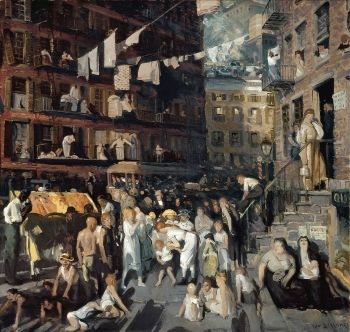
The Fourteenth Street School painters were influenced by the earlier Ashcan School, which, led by Robert Henri, emphasized realist painting at the turn of the century, rejecting both the academic art of the National Academy of Design and the influence of Impressionism. Henri worked and taught in Philadelphia where he became a mentor to John Sloan, George Luks, Everett Shinn, and William James Glackens, and, around the turn of the century, all of them relocated to New York City. In New York, Henri's student George Bellows became a leading painter of the group, giving the movement its name with his painting Disappointments of the Ash Can (1915). Influenced by earlier masters, including Frans Hals, Diego Velázquez, Francisco de Goya and the later Realists Édouard Manet and Edgar Degas, the movement applied classical methods to realistically portray the grittiness of American urban life. Distancing their work from the modernist "art for art's sake" mantra, Henri described their work as "art for life's sake." Teaching at the Art Students League in New York, Sloan and Henri taught and influenced the Fourteenth Street School painters.
Kenneth Hayes Miller
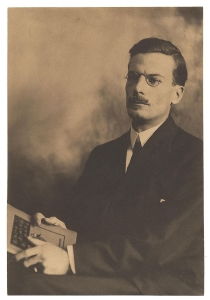
Growing up in upstate New York, Kenneth Hayes Miller moved to New York City as a young man where he studied at the Art Students League. His early works were influenced by Albert Pinkham Ryder, but by the early 1920s, influenced by Renaissance and Baroque masters, he turned to figurative treatments of women shoppers along Fourteenth Street, as seen in In Passing (1920). As art historian M. Sue Kendall wrote, "In their classical poses and formalized compositions, Miller's shoppers become ovoid and columnar forms in cloche hats and chokers." In 1911 he began teaching at the Art Students League, a position he held until 1951, where he influenced several generations of artists, including Edward Laning, Isabel Bishop, and Reginald Marsh, core members of the Fourteenth Street School.
Believing that the modern, leading European artists Matisse and Picasso had forfeited art's social function in favor of a style that emphasized artistic personality, Miller emphasized a more 'anonymous' approach based on classical rigor to depict contemporary life. At the Art Students League he primarily taught composition, with an emphasis on Renaissance principles, and life studies. In his own practice, he emphasized the figure, as seen in Shopper (1928), throughout his career, and his subject matter became a defining characteristic of the Fourteenth Street School, sometimes also dubbed the "Miller gang." Though Miller advocated for realism and a logical internal design as seen in the old master tradition, he also felt that that art should be contemporary and based upon what he called "plastic" and "significant" form.
The Whitney Studio Club
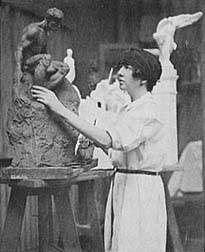
Gertrude Vanderbilt Whitney, the heiress and art patron, founded the Whitney Studio Club in 1918 and subsequently named Miller and his students as members. The art club became a hub for artists, who gathered there and developed longtime associations, and it organized traveling exhibitions. Art critic Forbes Richard said in 1927 that the Whitney Studio Club "had probably done more than any other single institution to bring to the notice of the public the creative younger artists." Often considered counter to the influence of Alfred Stieglitz's 291 gallery, which promoted avant-garde work, the club provided a vital outlet for Fourteenth Street School realism. The Whitney Studio Club continued until 1930, though in 1928, it launched the Whitney Studio Galleries, and in 1931 became the Whitney Museum of American Art, where Edward Laning's work was featured in its first major exhibition.
The Arts
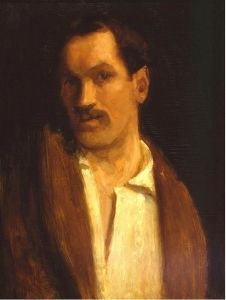
The Fourteenth Street School was also promoted in The Arts, a magazine founded in 1919 by the artist and art patron Hamilton Easter Field. It espoused the progressive American values also promoted by Mrs. Whitney, who provided financial support to the magazine. Devoted "entirely to significant works of the present and past that are in tune with the grand tradition of all time," the magazine advocated a broad-minded approach, "for neither the radical nor the conservative...[but]...to stand with the American artist." In 1923, the magazine featured Reginald Marsh as an upcoming painter of "America's grand subject," and played a critical role in establishing the Fourteenth Street School.
The “Poor Man's 5th Avenue”
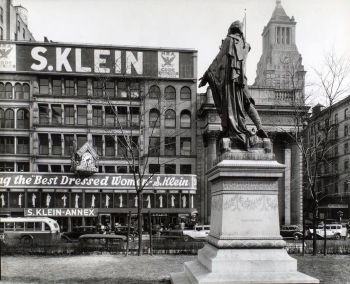
The area around Fourteenth Street became known in the 1920s as "the poor man's Fifth Avenue," for its department stores selling affordable fashions. Businessmen and local politicians launched a revitalization of the depressed neighborhood and promoted it as a rising mercantile center, reflecting American progressivism and rising middle class prosperity. By 1930, the neighborhood included a number of major banks, entertainment venues, the Consolidated Edison Company, and retail department stores, including Hearn's and Klein's, which attracted thousands of shoppers. Albert Halper, known for his novel Union Square (1933), described the contradictory nature of the dynamic neighborhood, writing, "In my estimation Union Square, while a facet of the American scene, is not typically American at all. A visitor from the South, the Middle-west or the Pacific coast, is struck by the foreignness of the section at the very first glance....But in its flavor, its pushing, unconscious brutality, its search for bargains even at the fracture of a limb, its busy shoppers on one side of the street and aimless, floating crowds on the other side, there is something American to the core." Halper also explained, "The noise was terrific, everything was bedlam....Everywhere you turned a vender shoved an object under your nose, yelling, screaming, urging you to buy."
The Fourteenth Street School artists had studios in the inexpensive neighborhood and primarily portrayed its inhabitants, though with different perspectives. While Miller and Bishop eschewed any depiction of its social and economic tensions, Soyer and Laning portrayed the rougher side of the neighborhood, particularly during the 1930s as the effects of the Great Depression took hold.
Concepts and Styles
New Woman
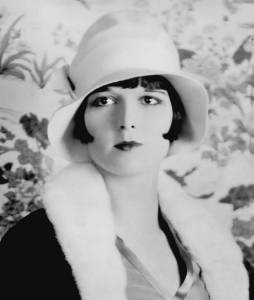
Charles Reade, a novelist, first used the term "New Woman" in 1877, as he argued for equal treatment for women, and, subsequently the novelist Henry James popularized the term in Daisy Miller (1878) and Portrait of a Lady (1880-81), portraying female protagonists with economic and personal independence. Driven by cultural and political changes, the image of the New Woman went through several subsequent incarnations; after World War I, the New Woman morphed into the Gibson girl, a young modern woman who worked outside the home and often challenged middle class values, and in the 1920s, the New Woman informed the "flapper" who was known for youthful fashion and a jazz age lifestyle. Society underwent rapid changes, as many women entered the work force, and in the 1920s many young women worked in banks or at department stores, even while marriage was still considered the ideal. The Fourteenth Street School artists variously interpreted the New Woman; Isabel Bishop portrayed "the career girl" or "office girl," Miller depicted the middle-class shopper, and Reginald Marsh pioneered the "Marsh girl," a femme fatale. As art historian Ellen Wiley Todd wrote, "Through their works, [they] kept in play the multiplicity of debates about women and the contradictory experience and representation of 'new women' and a 'new womanhood' between the wars."
Murals
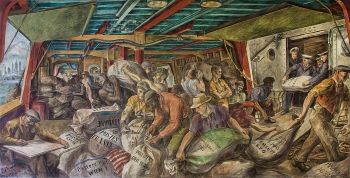
Most of the Fourteenth Street School artists created easel-size paintings, but in the 1930s, Miller, Bishop, Marsh, and Laning joined the ranks of many artists who worked on projects sponsored by the Works Progress Administration to counteract the effects of the Great Depression and created a number of mural projects. Laning's The Story of the Recorded Word (1938-1942), a series of murals painted for the New York Public Library, became his most famous work, and he continued making murals into the 1980s. Also acclaimed were Reginald Marsh's sixteen murals, depicting harbor scenes and famous navigators, painted for the U.S Custom House in New York City between 1936 and 1937. The artists also worked throughout the country, as Bishop painted her mural Great Men Come from the Hills (1938) for a post office in New Lexington, Ohio, and Marsh painted Unloading the Mail (1936) for a federal building in Washington, D.C.
Etchings and Prints
In addition to painting, Miller, Bishop, and Marsh emphasized etchings and print making throughout their careers. This trend was influenced by both the tradition of illustration that informed American realism, beginning with the Ashcan School, and by the classical etchings of the Old Masters. With works such as Noon Hour (1935), Bishop became known as a leading New York printmaker, and she continued making etchings into the 1960s when she adopted both the use of aquatint and a more abstracted treatment of the background as seen in her Nude (1961). Miller's etchings were often reproductions of his notable paintings, while Soyer's etchings in the 1930s depicting the unemployed and the poor of the Bowery were among the most acclaimed of the era.
Later Developments - After Fourteenth Street School
In the late 1930s the Fourteenth Street School, along with other movements like American Regionalism that emphasized realistic treatments of American subjects, came under fire as being as too conservative and nationalistic, and by 1940 the school as a movement had come to an end. The artists pursued divergent paths and explored new subject matter while retaining an interest in realistic depictions. Marsh turned to illustrating for leading magazines, including Life and Esquire, and returned to teaching, where he was a noted influence on his student Roy Lichtenstein. At the same time while developing techniques that blurred the definition between painting and drawing, Bishop began painting nudes, which were much admired by Willem de Kooning.
With the rise of Abstract Expressionism and as the Fourteenth Street School artists were overlooked, some of the group launched counter initiatives on behalf of representational art. In 1953, Bishop cofounded Reality: a Journal of Artists' Opinions and invited Raphael Soyer and his brother Moses, Marsh, Edward Hopper, Guy Pène du Bois, Leon Kroll, Yasuo Kuniyoshi, Jack Levine, and Chaim Gross to join the meetings held in connection with the journal, dedicated "to the defense of any painter's right to paint any way he wants." In the 1960s, Soyer wrote his first memoir A Painter's Pilgrimage (1962), followed by his noted study Thomas Eakins (American, 1844-1916), and became the leading advocate for representational art in New York's literary and artistic circles.
The Fourteenth Street School's continued advocacy of representational art influenced the 1960s development of Contemporary Realism, spearheaded by Fairfield Porter who early in his career studied at the Art Students League. As artists like Alex Katz, Philip Pearlstein, Lois Dodd, Neil Welliver, and Jane Freilicher, turned to realist art, the Fourteenth Street School artists were rediscovered in the 1970s. The School of London, another representational movement led by Lucian Freud, David Hockney, and Francis Bacon in the 1970s, further established a new critical context that brought forward the work of the Fourteenth Street artists, and during this period three major studies of Isabel Bishop's work were published.
